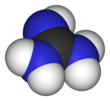
Back جوانيدين Arabic Quanidin Azerbaijani قوانیدین AZB গুয়ানিডিন Bengali/Bangla Guanidina Catalan Guanidin Czech Guanidin German Guanidino Esperanto Guanidina Spanish Guanidina Basque
| |||
| |||
| Names | |||
|---|---|---|---|
| Preferred IUPAC name
Guanidine[1] | |||
| Other names
Iminomethanediamine
| |||
| Identifiers | |||
3D model (JSmol)
|
|||
| 506044 | |||
| ChEBI | |||
| ChEMBL | |||
| ChemSpider | |||
| DrugBank | |||
| ECHA InfoCard | 100.003.656 | ||
| EC Number |
| ||
| 100679 | |||
| MeSH | Guanidine | ||
PubChem CID
|
|||
| UNII | |||
CompTox Dashboard (EPA)
|
|||
| |||
| |||
| Properties | |||
| CH5N3 | |||
| Molar mass | 59.072 g·mol−1 | ||
| Melting point | 50 °C (122 °F; 323 K) | ||
| log P | −1.251 | ||
| Conjugate acid | Guanidinium | ||
| Thermochemistry | |||
Std enthalpy of
formation (ΔfH⦵298) |
−57 – −55 kJ mol−1 | ||
Std enthalpy of
combustion (ΔcH⦵298) |
−1.0511 – −1.0531 MJ mol−1 | ||
| Pharmacology | |||
| Pharmacokinetics: | |||
| 7–8 hours | |||
| Hazards | |||
| Lethal dose or concentration (LD, LC): | |||
LD50 (median dose)
|
475 mg/kg (oral, rat)[2] | ||
| Related compounds | |||
Related compounds
|
|||
Except where otherwise noted, data are given for materials in their standard state (at 25 °C [77 °F], 100 kPa).
| |||
Guanidine is the compound with the formula HNC(NH2)2. It is a colourless solid that dissolves in polar solvents. It is a strong base that is used in the production of plastics and explosives. It is found in urine predominantly in patients experiencing renal failure.[3] A guanidine moiety also appears in larger organic molecules, including on the side chain of arginine.
- ^ International Union of Pure and Applied Chemistry (2014). Nomenclature of Organic Chemistry: IUPAC Recommendations and Preferred Names 2013. The Royal Society of Chemistry. p. 883. doi:10.1039/9781849733069. ISBN 978-0-85404-182-4.
- ^ "Guanidine hydrochloride". ChemIDplus. National Library of Medicine. Archived from the original on 2014-08-12. Retrieved 2014-08-10.
- ^ Sawynok J, Dawborn JK (1975). "Plasma concentration and urinary excretion of guanidine derivatives in normal subjects and patients with renal failure". Clinical and Experimental Pharmacology & Physiology. 2 (1): 1–15. doi:10.1111/j.1440-1681.1975.tb02368.x. PMID 1126056. S2CID 41794868.
© MMXXIII Rich X Search. We shall prevail. All rights reserved. Rich X Search



